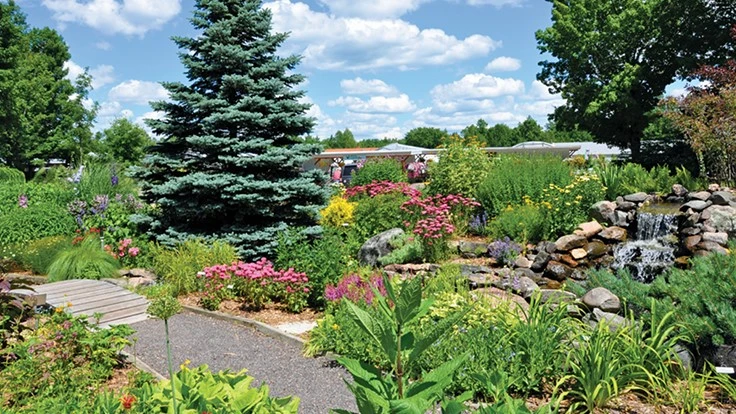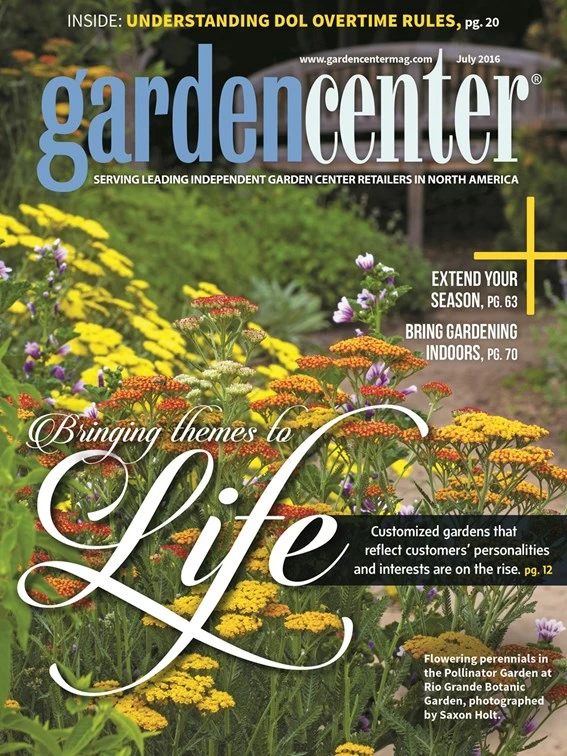
PHOTOS COURTESY OF WINTER GREENHOUSE

Gardening is a personal experience. When spending time outside, people like to feel that they’re in a place of their own making — a place that suits them. This may be why gardeners are beginning to see the value of customized theme gardens that fit their own tastes and sensibilities. Garden center retailers are also starting to see the value in displaying and offering ideas for theme gardens that customers can implement at home.
These themed display gardens also have the potential to take a business beyond the realm of retail and turn it into a visual destination that customers will happily take a road trip to see. This has been a particularly successful strategy for Winter Greenhouse.
Located in Winter, Wis., visitors to Winter Greenhouse can tour an expansive display garden area, covering roughly 1.5 acres, and find sections of everything from shade and sun gardens, water gardens, rock gardens, natives, edibles and many other themes. The team at Winter Greenhouse also installs themed gardens and landscapes at customers’ homes.
The landscaping division of Winter Greenhouse offers a highly customized experience for customers, including optional garden themes such as herb, fragrant, butterfly, cutting, native and rock gardens.
General Manager Jim Wilson says the display gardens have been a central aspect of the business since shortly after Winter Greenhouse opened in 1984. The landscaping side of the business has been operating for about eight years. The home landscape installations used to be done on properties up to 100 miles away, but Wilson says the radius has become more focused.

“Now we try to keep it within 50 miles,” Wilson says. “We’re kind of in the hub of three or four bigger towns that are 30 to 35 miles away, so we have to travel around. [The town of] Winter is just 330 [residents], there’s not much local business for us, so we have to travel a bit.”
Located in rural Wisconsin, Winter Greenhouse isn’t exactly inundated with nearby high-population cities. Wilson says this created a need for the display gardens early on: Customers needed a destination to make the trip worthwhile and memorable.
“From the beginning, when we started, there wasn’t that much going on,” Wilson says. “Our display gardens, for us, were crucial in a way, because we’re so remote, we had to get something to attract people out here. That, plus the variety of plants that we had. We really got into a wide variety because we had to be able to pull people so that they would come and stay for a while and make it worth the trip.”
Our display gardens, for us, were crucial in a way, because we’re so remote, we had to get something to attract people out here.” – Jim Wilson, general manager
A glimpse at the possibilities. Having pretty flowers to look at is all well and good, but Wilson says the goal of display gardens goes beyond appearances. Customers also need information about the plants they’re interested in. By maintaining a variety of theme gardens around the business, Winter Greenhouse shows visitors what they can expect from theme gardens at their own homes.
“For us, the display garden was also to show what’s hardy,” Wilson says. “When people are coming and they’re buying, they can see a fully grown plant and not just a plug or newly-transplanted plant. So, it was more than just the aesthetics of seeing something beautiful. It was practical — ‘what does this plant actually look like when it’s out in the field and how hardy is it?’ It became kind of a combination of that trial garden and display kind of aesthetics.”

“It’s a great selling tool,” he adds. “It’s pretty common, when [a plant is] blooming in the display garden, that people are asking, ‘What is that plant and where can I buy it?’”
By representing various garden themes in the company’s displays, Landscape Manager Kelly Larsen says Winter Greenhouse is able to help customers focus specifically on what plants they’re interested in and what kind of personality they want their gardens to have. Although many customers don’t come to the grower/retailer with a particular theme in mind, the categories exemplified in the displays help to simplify the decision-making process.
“I don’t know how many people are really buying plants according to themes, but on the other hand, when you quiz people about what they want to plant … of course, they’re going to say, ‘Well, we have a lot of shade.’ Okay, so you’re going to go with more shade plants, then you can ask them what their color preference is and try to focus in on what their wishes are,” Larsen says.
Showing home gardeners the potential of their green spaces is also one of the goals of Marin Art & Garden Center in Ross, Calif., a nonprofit horticultural education facility with roughly 11 acres of theme garden displays. Although Marin isn’t a retail operation, it has a vested interest in helping visitors visualize their own personalized theme gardens, says Executive Director Antonia Adezio.

“We are striving to continuously show our visitors new ideas and trends in gardening that are useful for them at home,” Adezio says. “So, we’re paying attention to new plants that come out in the trade and also different ways of using them.”
Adezio says more retail garden centers could benefit from going beyond displays made up of simple containers and beds — living, thriving theme gardens make much better examples for what customers can try at home. The team at Marin Art & Garden Center applies this principle when maintaining the facility’s display areas.
“The individual garden areas [at Marin] are mostly comparable to what you might do at home,” she says. “It’s pretty easy, I think, to interpret what we’re doing here and do it in a backyard. To see how plants combine is really important, to see which things are flowering at the same time so you can plan that way. I think the more that you can do that in the garden center, the better you’re going to be at serving your customers.”
Staying current. Displaying and offering a wide range of theme gardens demands close attention to trendy plants and ever-changing customer preferences. Wilson says he sees consumer interest in particular for shade and sun plants, water gardens and rock gardens in his market.
Winter Greenhouse also attempts to encourage patrons to take part in the pollinator garden movement. This is done by promoting and selling special bundles of pollinator-friendly natives.
“We’ve been stressing that especially this year, because we’re concerned just like everyone about pollinators and promoting them,” Wilson says. “That’s been popular also.”

On the other hand, Wilson says organic gardening is less popular with his customers than he’d like.
“People out here aren’t as interested in natives or organics, although you’d think, being in a rural area … but somehow it’s more of an urban attraction,” Wilson says. “We’ve never been able to really press the organic thing here, we’ve tried. We do it ourselves in our own garden and we believe in it, but the market … people aren’t willing to pay as much out here for it.”
As Wilson has learned in the case of organic gardening, trends are often determined according to the old adage: location, location, location. In California, Adezio says water- and environmentally conscious gardening is a popular theme with visitors to Marin Art & Garden Center.
“The [themes] that we’re really interested in focusing on are oriented toward habitat and water conservation because those are really big themes for us here in California,” Adezio says. “We have had to all really start thinking about using water in very strategic ways and changing our backyard gardens as a result of that. So, there’s quite a lot of interest now in learning how to do that and have it still be beautiful. We are definitely trying to help people understand that.”
Themes are also often influenced by seasonal tastes, which can change without warning, Larsen says.

“It changes every season. In the spring, they want this and that, then in the summer, the phlox are blooming and everybody wants phlox,” Larsen says. “It’s tough to do signage because of the seasons changing and the plants overgrowing and that sort of thing, that is an ongoing challenge.”
A flexible and adaptive staff has helped Winter Greenhouse stay competitive despite the challenges of investing in so many plant categories, Wilson says.
“The type of people that you have working for you have to be flexible and always wanting to learning something new and not minding changing quickly into another department,” Wilson says.
“It requires a certain kind of person and certain kind of organization to be able to do that. So, it’s challenging, but that makes it very interesting and the diversity keeps us going. You’re not dependent on one market … we can keep ourselves going that way.”
When a visitor walks away from Winter Greenhouse with ideas and inspiration for their home gardens, it’s a win. However, either way, Wilson is satisfied knowing customers have enjoyed the atmosphere of the business.
“Because of the [plant] diversity, it creates a certain trend and atmosphere,” Wilson says. “People also come just because of the feeling they get when they’re here, they feel good, they feel peaceful. They like the beauty, of course. That’s why people keep coming back. They enjoy themselves when they’re here.”

Explore the July 2016 Issue
Check out more from this issue and find your next story to read.
Latest from Garden Center
- [WATCH] Looking Back to Spring Ahead: Where we’ve been & where the industry is headed in 2026
- Seed Your Future plans to bring 80+ students to MANTS 2026
- Donna McGinnis named next CEO of Denver Botanic Gardens
- HRI Leadership Academy opens applications for 2027 class
- Sustainabloom introduces Sustainability Planning Template for Retail Florists
- Burpee releases commemorative seed collection to celebrate America's 250th anniversary
- New Michigan box tree moth alert available in English and Spanish
- Seed Your Future announces board updates, 2025 Cross-Curricular Career Lessons





